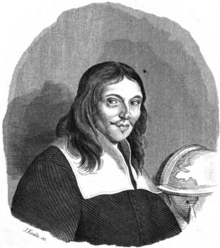Jacob Roggeveen
Jacob Roggeveen | |
|---|---|
| Born | 1 February 1659 |
| Died | 31 January 1729 (aged 69) |
| Nationality | Dutch |
| Other names | Roggewein, Commodore |
| Education | University of Harderwijk |
| Employer | Dutch West India Company |
| Spouse(s) | Marija Margaerita Vincentius, Anna Adriana Clement |
| Parent(s) | Arend Roggeveen, Maria Storm |
Jacob Roggeveen (1 February 1659 – 31 January 1729) was a Dutch explorer who was sent to find Terra Australis and Davis Land,[1] but instead found Easter Island (called so because he landed there on Easter Sunday). Jacob Roggeveen also found Bora Bora and Maupiti of the Society Islands, as well as Samoa. He planned the expedition along with his brother Jan Roggeveen, who stayed in the Netherlands.[2]
Early career

His father, Arend Roggeveen, was a mathematician with much knowledge of astronomy, geography, rhetorics, philosophy, and the theory of navigation as well. He occupied himself with study of the mythical Terra Australis, and even got a patent for an exploratory excursion,[2] but it was to be his son who, at the age of 62, eventually equipped three ships and made the expedition.
He became
He became involved in religious controversies, supporting the liberal preacher Pontiaan van Hattem by publishing his leaflet De val van 's werelds afgod (The fall of the world's idol). The first part appeared in 1718 in Middelburg, and was subsequently confiscated by the city council and burned. Roggeveen fled from Middelburg to nearby Flushing. Thereafter he established himself in the small town of Arnemuiden, and published parts 2 and 3 of the series, again raising a controversy.
Explorations

On 1 August 1721 he headed an expedition sponsored by the Dutch West India Company, the rivals of the VOC, to seek Terra Australis and to open a western trade route to the "Spice islands".[3] His fleet consisted of three ships, the Arend, the Thienhoven, and Afrikaansche Galey and had 223 men on crew.

Roggeveen first sailed down to the
After his return, Roggeveen published part 4 of his work, De val van 's werelds afgod.
Notes
- ISBN 9780547561639. Retrieved 15 September 2021.
- ^ a b "Jacob Roggeveen". Libweb5.princeton.edu. Archived from the original on 7 October 2016. Retrieved 18 October 2012.
- ^ a b c d Quanchi, Historical Dictionary of the Discovery and Exploration of the Pacific Islands, page 217
- ^ "Chauvet - Easter Island". Chauvet-translation.com. Retrieved 18 October 2012.
- ISBN 9780520261143.
References
- The Journal of Jacob Roggeveen, edited by Andrew Sharp, Oxford University Press, 1970
- Who's Who in Pacific Navigation, John Dunmore Melbourne University Press 1972
- Quanchi, Max (2005). Historical Dictionary of the Discovery and Exploration of the Pacific Islands. The Scarecrow Press. ISBN 0810853957.
- Extract from the Official log of Jacob Roggeveen reproduced in Bolton Glanville Corney, ed. (1908), The voyage of Don Felipe Gonzalez to Easter Island in 1770-1, Hakluyt Society, p. 3, retrieved 13 January 2013
